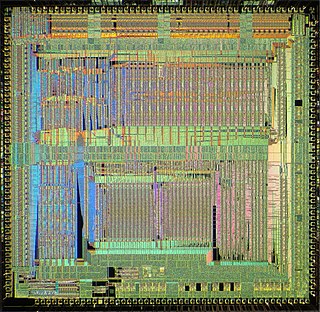Related Research Articles

Sun Microsystems, Inc. was an American technology company that sold computers, computer components, software, and information technology services and created the Java programming language, the Solaris operating system, ZFS, the Network File System (NFS), and SPARC microprocessors. Sun contributed significantly to the evolution of several key computing technologies, among them Unix, RISC processors, thin client computing, and virtualized computing. Notable Sun acquisitions include Cray Business Systems Division, Storagetek, and Innotek GmbH, creators of VirtualBox. Sun was founded on February 24, 1982. At its height, the Sun headquarters were in Santa Clara, California, on the former west campus of the Agnews Developmental Center.

The Cray-1 was a supercomputer designed, manufactured and marketed by Cray Research. Announced in 1975, the first Cray-1 system was installed at Los Alamos National Laboratory in 1976. Eventually, 80 Cray-1s were sold, making it one of the most successful supercomputers in history. It is perhaps best known for its unique shape, a relatively small C-shaped cabinet with a ring of benches around the outside covering the power supplies and the cooling system.

Convex Computer Corporation was a company that developed, manufactured and marketed vector minisupercomputers and supercomputers for small-to-medium-sized businesses. Their later Exemplar series of parallel computing machines were based on the Hewlett-Packard (HP) PA-RISC microprocessors, and in 1995, HP bought the company. Exemplar machines were offered for sale by HP for some time, and Exemplar technology was used in HP's V-Class machines.
Alliant Computer Systems Corporation was a computer company that designed and manufactured parallel computing systems. Together with Pyramid Technology and Sequent Computer Systems, Alliant's machines pioneered the symmetric multiprocessing market. One of the more successful companies in the group, over 650 Alliant systems were produced over their lifetime. The company was hit by a series of financial problems and went bankrupt in 1992.
Minisupercomputers constituted a short-lived class of computers that emerged in the mid-1980s, characterized by the combination of vector processing and small-scale multiprocessing. As scientific computing using vector processors became more popular, the need for lower-cost systems that might be used at the departmental level instead of the corporate level created an opportunity for new computer vendors to enter the market. As a generalization, the price targets for these smaller computers were one-tenth of the larger supercomputers.

Bipolar Integrated Technology, Inc. (BIT), later Bit, Inc., was a privately held semiconductor company based in Beaverton, Oregon, which sold products implemented with emitter-coupled logic technology. The company was founded in 1983 by former Floating Point Systems, Intel, and Tektronix engineers. The company, which occupied a 46,000-square-foot manufacturing facility manufacturing facility at the Oregon Graduate Center, raised $36 million in start-up capital within three years of its foundation.

Floating Point Systems, Inc. (FPS), was a Beaverton, Oregon vendor of attached array processors and minisupercomputers. The company was founded in 1970 by former Tektronix engineer Norm Winningstad, with partners Tom Prince, Frank Bouton and Robert Carter. Carter was a salesman for Data General Corp. who persuaded Bouton and Prince to leave Tektronix to start the new company. Winningstad was the fourth partner.
Cydrome (1984−1988) was a computer company established in San Jose of the Silicon Valley region in California. Its mission was to develop a numeric processor. The founders were David Yen, Wei Yen, Ross Towle, Arun Kumar, and Bob Rau.

The CDC 6000 series is a discontinued family of mainframe computers manufactured by Control Data Corporation in the 1960s. It consisted of the CDC 6200, CDC 6300, CDC 6400, CDC 6500, CDC 6600 and CDC 6700 computers, which were all extremely rapid and efficient for their time. Each is a large, solid-state, general-purpose, digital computer that performs scientific and business data processing as well as multiprogramming, multiprocessing, Remote Job Entry, time-sharing, and data management tasks under the control of the operating system called SCOPE. By 1970 there also was a time-sharing oriented operating system named KRONOS. They were part of the first generation of supercomputers. The 6600 was the flagship of Control Data's 6000 series.
Systems Engineering Laboratories was a manufacturer of minicomputers in Fort Lauderdale, Florida. It was one of the first 32-bit realtime computer system manufacturers. Realtime computers are used for process control and monitoring.

Altos Computer Systems was founded in 1977 by David G. Jackson and Roger William Vass Sr. It focused on small multi-user computers, starting with multi-user derivatives of CP/M, and later including Unix and Xenix-based machines. In its 1982 initial public offering on NASDAQ, the company raised $59M. Thereafter the company's stock was traded under the symbol ALTO.
The Compaq Professional Workstation was a family of workstations produced by Compaq. Introduced in late October 1996, the first entry in the family featured single or dual Pentium Pro processors. Later entries featured Pentium IIs and IIIs; the XP1000 was the only non-x86 based entry, featuring a DEC Alpha processor. Compaq aimed the Professional Workstation at computer-aided design users, software programmers, multimedia designers and financial workers. While workers of those fields primarily ran Unix-based operating systems on workstations at the time, the Compaq Professional Workstation came preinstalled with Windows NT 4.0 Workstation. The line was discontinued in 2002.

OCR Systems, Inc., was an American computer hardware manufacturer and software publisher dedicated to optical character recognition technologies. The company's first product, the System 1000 in 1970, was used by numerous large corporations for bill processing and mail sorting. Following a series of pitfalls in the 1970s and early 1980s, founder Theodor Herzl Levine put the company in the hands of Gregory Boleslavsky and Vadim Brikman, the company's vice presidents and recent immigrants from the Soviet Ukraine, who were able to turn OCR System's fortunes around and expand its employee base. The company released the software-based OCR application ReadRight for DOS, later ported to Windows, in the late 1980s. Adobe Inc. bought the company in 1992.

Librex Computer Systems Inc. was a short-lived American subsidiary of the Nippon Steel Corporation that manufactured notebook computers from 1990 to 1992. Librex had roots in Nippon Steel's Electronics and Information Systems Division (EISD) back in Japan, which starting in 1986 had formed joint ventures with several high-profile American computer companies. Librex was Nippon Steel EISD's first venture in the United States; it also set up Nippon Steel Computer PLC in the United Kingdom to sell identical products. The company's notebooks received praise in the technology press, but a fierce price war in the market for laptops in the early 1990s combined with dwindling profit margins compelled Nippon Steel to dissolve Librex in 1993.
Pacific Cyber/Metrix, Inc. was an American computer company based in California. The company was founded in 1975 in San Ramon, California.

OPTi Inc. was a fabless semiconductor company based in Milpitas, California, that primarily manufactured chipsets for personal computers. The company dissolved in 2001 and transferred its assets to the unaffiliated non-practicing entity OPTi Technologies

Aox Inc. was a privately run American technology corporation founded by Michael and Linda Aronson in 1978. Over the course of its 22-year lifespan, the company chiefly developed software and hardware for IBM's PC and compatibles, for the Personal System/2, and for the Macintosh. In its twilight years, the company designed multimedia and teleconferencing devices and chip designs. Aox was founded after Michael Aronson graduated from Harvard University with a doctorate in physics; he stayed with the company until 2000, when he incorporated EndPoints Inc. and switched to full-time fabless semiconductor design.

Cumulus Corporation was an American computer peripheral and system manufacturer active from 1987 to 1993. Based in Beachwood, Ohio and started by Tecmar founder Martin Alpert, the company set out to exclusively manufacture expansion products for IBM's Personal System/2 (PS/2) family of computers—mainly RAM expansion cards. It later released cross-platform CPU upgrade cards and memory expansion cards for other platforms besides the PS/2. Beginning in 1990, the company began trading as Cumulus Computer Corporation and began releasing complete systems of their own. Initially a success story for the tech industry in Cleveland, a botched stock launch in 1992 proved disastrous for the company's ailing cash flow situation, and in 1993 the company was liquidated amid massive debt to suppliers and lenders.
Pronto Computers, Inc., was an American computer company based in Torrance, California, active from 1983 to 1987. During its brief existence, the company released a duo of IBM PC compatible computer systems and a family of high-spec graphics cards. Pronto's first product, the System 16, was widely lauded for its graphical prowess and industrial design; in 1983, I.D. magazine named it the best-designed product in the field of instrumentation and equipment. The System 16 was followed up with the Pronto Transportable Solution, a portable computer. Both it and the Pronto 16 ran the Intel 80186, a microprocessor seldom used in IBM PC compatibles. Pronto Computers went bankrupt shortly after the Black Monday financial crisis of 1987.
References
- ↑ Staff writer (April 15, 1988). "Ailing Celerity Computing Says Agreement Signed for Purchase". The Los Angeles Times. The Times Mirror Company: 2J – via Newspapers.com.
- ↑ Berger, Dan (March 24, 1985). "This firm acts with Celerity". The San Diego Union: I-1 – via ProQuest.
- ↑ Berger, Dan (January 27, 1986). "Celerity Computing unveils 2 superfast minicomputers". The San Diego Union: D-16 – via ProQuest.
- ↑ Gibson, Stanley (February 15, 1988). "Layoffs, low funds ail Celerity". Computerworld. IDG Publications. XXII (7): 8 – via Google Books.
- 1 2 Staff writer (March 24, 2002). "The Sun Still Shines on Sun's Local Unit". San Diego Business Journal. Archived from the original on February 12, 2023.
- ↑ Staff writer (September 17, 1984). "Celerity: 32-bit engineering unit faster than VAX-11". Computerworld. IDG Publications. XVIII (38): 69 – via Google Books.
- ↑ Henkel, Tom (September 10, 1984). "Demand for 32-bit workstations outgrowing supply". Computerworld. IDG Publications. XVIII (37): 16–18 – via Google Books.
- ↑ Staff writer (1987). "Celerity Minisuper Uses New ECL to Run at 160 MPS". Electronics. McGraw-Hill. 60: 158 – via Google Books.
- ↑ Rose, Craig D. (April 15, 1988). "Another battered firm in Oregon to buy Celerity Computing". The San Diego Union: D1 – via ProQuest.
- ↑ Phelps, Christi (September 5, 1988). "Floating Point Pins Hopes on Unfinished Minisupercomputer". San Diego Business Journal: 1 – via ProQuest.
- ↑ Staff writer (October 31, 1989). "FPS Computing Claims 64-bit 500EA Trounces Convex C-2". Computer Business Review. New Statesman Media Group. Archived from the original on February 12, 2023.